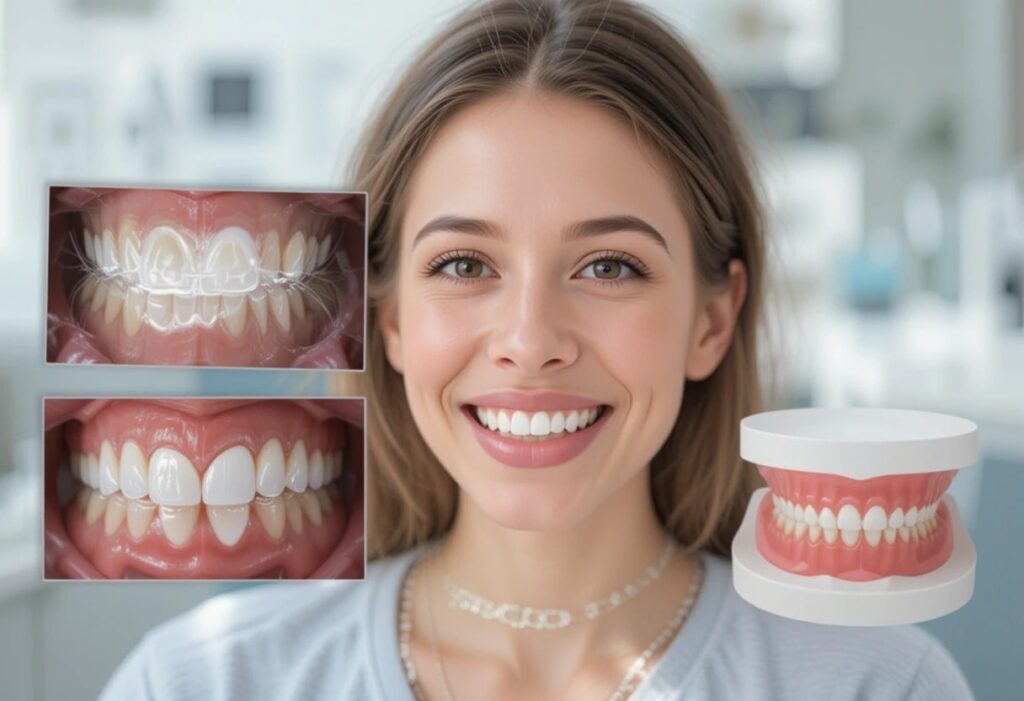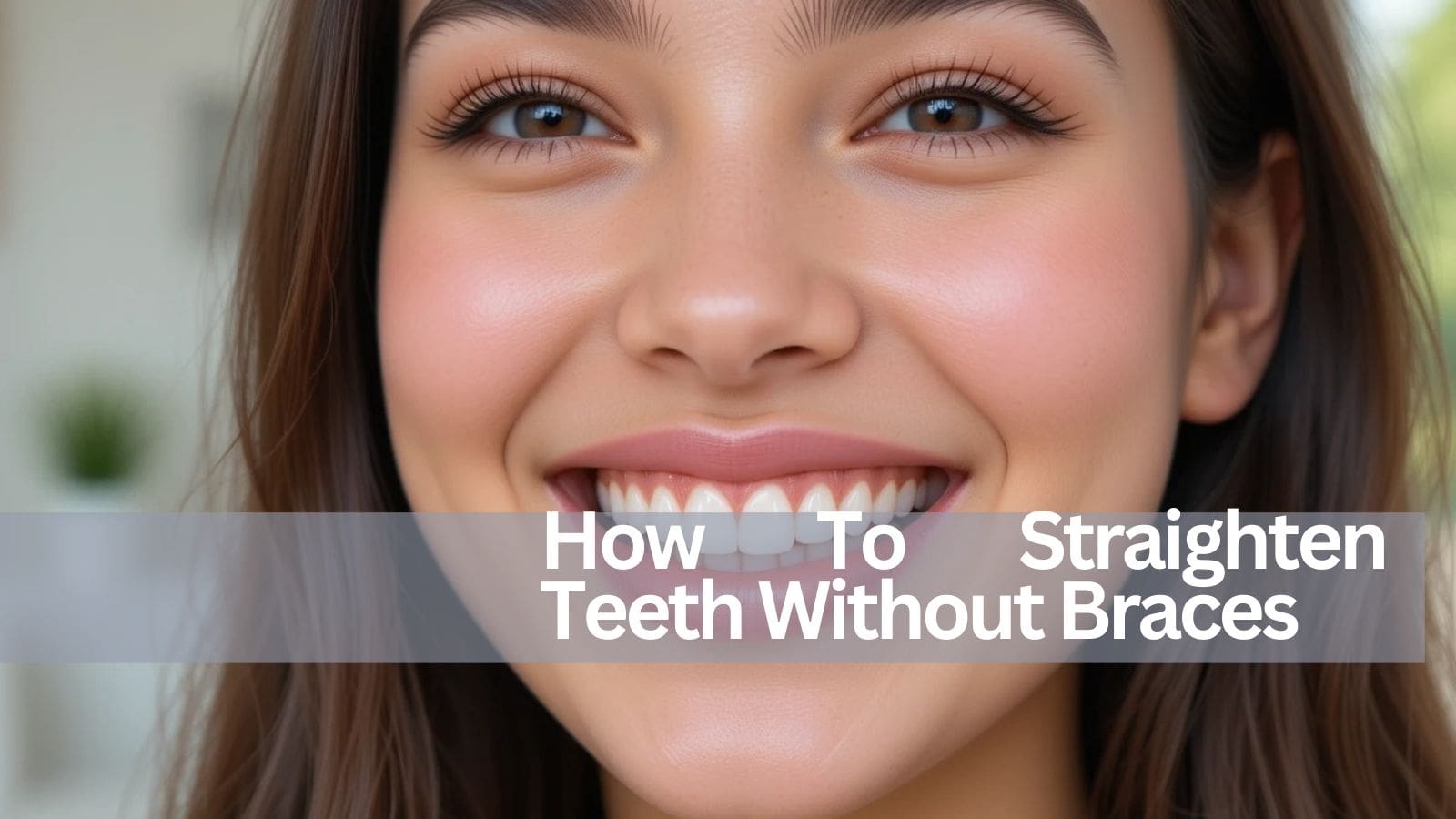When I wanted to straighten my teeth without braces, I decided to try Invisalign. It was amazing because it was clear, comfortable, and I barely noticed I was wearing it. Over time, I saw my teeth become straighter, and it was a great alternative to traditional braces!
If you’re looking for ways to straighten teeth without braces, options like Invisalign, porcelain veneers, and dental bonding can help. These treatments are discreet, comfortable, and effective for mild to moderate misalignment. Be sure to consult a dentist to find the best choice for you.
Stay tuned with us! In the next few moments, we’ll talk about how to straighten teeth without braces and explore some great alternatives. You won’t want to miss this, as we share tips that could work for you!
Teeth Straightening And Its Importance – Benefits You Should Know!

Before delving into how to straighten teeth without braces, it’s essential to understand what teeth straightening entails. Teeth straightening is an orthodontic treatment designed to correct irregularities in teeth alignment. These irregularities, such as overbites, underbites, and crooked teeth, are usually caused by malocclusion—misalignment of the teeth and bite.
Having straight teeth not only improves the aesthetics of your smile but can also boost your confidence, improve speech, and even make it easier to chew and bite food. Additionally, straight teeth are easier to clean, which can reduce the chances of developing tooth decay and gum disease.
Is It Possible To Straighten Teeth Naturally?
If you’re wondering whether you can fix misaligned teeth without any dental treatment, the truth is, that it’s not possible. Simple jaw exercises or tongue adjustments won’t shift your teeth enough to make a real difference. Teeth are firmly set in the jawbone; only professional treatments like retainers, aligners, or veneers can help straighten them.
That being said, good oral habits like maintaining proper tongue posture and avoiding excessive pressure on your teeth (such as thumb sucking) can prevent further misalignment. For the best results, it’s always a good idea to consult a dentist who can recommend the right solution for your needs.
Why Consider Straightening Teeth Without Braces?
Before diving into the methods, one must understand why straightening teeth without braces could be a preferred choice for some individuals. The advantages of alternative treatments include:
- Discreet Treatment: Many of these methods are less noticeable than traditional braces, which is essential for adults and teens.
- Comfort and Convenience: Some options are removable, allowing for easier maintenance and comfort.
- Less Invasive: Treatments like retainers and aligners don’t require as much alteration of your natural teeth.
Also read: Sports Harmonicode – The Future Of Athletic Performance!
Reasons To Straighten Your Teeth Without Braces – Reasons To Straighten Your Teeth Without Braces!
While traditional braces have been the go-to solution for teeth straightening for many years, more and more people are seeking alternatives. Some of the reasons to straighten teeth without braces include:
- Aesthetic Appeal: Many individuals prefer a more discreet method of teeth straightening, as traditional braces can be bulky and noticeable.
- Comfort: Alternative treatments like Invisalign aligners are more comfortable than metal braces, which can irritate the gums and the inside of the mouth.
- Convenience: Some alternatives, such as removable aligners, allow for easier brushing and flossing compared to braces.
- Less Treatment Time: Certain treatments like Invisalign can provide faster results than traditional braces, with treatment times ranging from 12 to 18 months, depending on the severity of the misalignment.
How To Straighten Teeth Without Braces – 5 Effective Methods!

Now that we’ve covered why you might choose to straighten your teeth without braces, let’s look at some of the most effective methods:
Invisalign Clear Aligners:
Invisalign has become one of the most popular methods for teeth straightening without braces. These aligners are made of clear plastic, making them nearly invisible when worn. Invisalign works by using a series of custom-made, removable aligners that gradually move your teeth into the desired position over time.
Advantages of Invisalign:
- Discreet Treatment: The aligners are clear, offering a more aesthetic solution compared to traditional metal braces.
- Comfort: The smooth plastic material eliminates the discomfort and irritation caused by metal brackets and wires.
- Removable: Aligners can be taken out while eating, drinking, or brushing, making it easier to maintain oral hygiene.
Treatment Duration: On average, Invisalign treatment takes about 12 to 18 months, but the timeline may vary based on the complexity of the case.
Cosmetic Dentistry for Mild Straightening:
For people with minor misalignments, cosmetic dentistry can offer solutions that do not involve braces. This includes procedures such as dental bonding, contouring, or veneers. These treatments are designed to reshape or cover up the teeth, giving them the appearance of being straighter.
Advantages:
- Quick Results: Cosmetic procedures can often be completed in a single appointment, providing immediate results.
- Minimal Discomfort: These treatments typically involve little to no pain.
Limitations: Cosmetic dentistry may not be suitable for significant misalignments, as it is more about improving the appearance rather than realigning the teeth.
Teeth Straightening Plates (Removable Plates):
Teeth straightening plates are removable devices that can be used to correct slight misalignments, particularly in younger children who still have their baby teeth. These plates work by gradually shifting teeth into better alignment.
Advantages:
- Non-invasive: These devices are less intrusive than braces and can be easily removed when necessary.
- Convenience: They can be worn as needed, making them ideal for younger patients who may not yet be ready for full braces.
Limitations: As children transition to adult teeth, further treatment, such as Invisalign, may be required to continue the straightening process.
Lingual Braces (Hidden Braces):
Lingual braces are similar to traditional metal braces but are placed on the inside of the teeth, making them less visible. These braces can be a good option for individuals who need more extensive teeth straightening but still want a discreet treatment.
Advantages:
- Discreet Appearance: Since the braces are placed on the back of the teeth, they are not visible to others.
- Effective for Severe Misalignments: Lingual braces can treat complex orthodontic cases that other non-invasive methods may not address.
Limitations: Lingual braces can be more difficult to clean and maintain, and they may be uncomfortable during the adjustment phase.
Porcelain Veneers:
Porcelain veneers are thin, custom-made shells that cover the front surface of the teeth. Veneers are a great solution for people with minor spacing issues or slightly crooked teeth. While they do not move teeth, they can make the teeth appear straighter.
Advantages:
- Immediate Results: Veneers can be applied quickly, giving an instant improvement to the appearance of your teeth.
- Natural Look: Porcelain mimics the natural appearance of tooth enamel, providing a realistic finish.
Limitations: Veneers are more suitable for aesthetic improvements rather than functional teeth straightening.
Comparing Teeth Straightening Methods Without Braces – Compare The Best Options!
When considering which method is best for you, it’s important to compare the options based on factors such as comfort, cost, effectiveness, and treatment time. Invisalign is typically the most popular option for adults seeking a discreet and effective solution. However, other options like porcelain veneers or cosmetic dentistry may be better for individuals with minor misalignments.
| Treatment Method | Comfort | Treatment Duration | Effectiveness | Cost |
| Invisalign | High | 12-18 months | Effective | Moderate |
| Cosmetic Dentistry | High | Immediate | Moderate | High |
| Teeth Straightening Plates | Moderate | Varies | Mild | Low |
| Lingual Braces | Moderate | 18-24 months | Effective | High |
| Porcelain Veneers | High | Immediate | Moderate | High |
Can Invisalign Aligners Straighten All Types Of Teeth Misalignment?
- Effective for mild to moderate misalignments: Invisalign is perfect for treating mild to moderate issues such as crooked teeth, slight gaps, or minor bite problems. It provides a comfortable, nearly invisible solution for those who don’t need drastic corrections to their smile.
- Not ideal for severe misalignments: While Invisalign works wonders for many, it may not be suitable for severe misalignments like large overbites, underbites, or major crowding. In these cases, traditional braces, which provide stronger and more targeted pressure, might be required to achieve desired results.
- Customizable for many cases: Invisalign aligners are custom-made to fit each patient’s teeth and correct misalignments over time. The system is highly flexible, addressing most common orthodontic issues, but treatment effectiveness depends on the severity and specific nature of the misalignment.
- Requires regular monitoring: To ensure that the aligners are progressing as planned, it’s important to have regular check-ups with an orthodontist. Monitoring your progress allows adjustments when needed, ensuring that the aligners move your teeth in the right direction for the best results.
- Consult your doctor: Before starting Invisalign treatment, it’s essential to consult with an experienced dentist or orthodontist. They will assess your dental condition and help determine if Invisalign is the best choice for you, offering personalized advice based on your specific needs and goals.
Is The Cost Of Invisalign Comparable To Traditional Braces?
The cost of Invisalign treatment can be similar to traditional braces, but it ultimately depends on the complexity of your case and the length of your treatment. For some patients, Invisalign may cost more due to the advanced technology and customized aligners. However, traditional braces can also add up in terms of additional visits and adjustments.
It’s important to check with your insurance provider, as many plans cover both options, though they might favor one over the other. Additionally, Invisalign often requires fewer visits to the orthodontist, which could save on costs in the long run. Financing options can also make Invisalign more accessible.
Can I Straighten My Teeth Without Seeing An Orthodontist?
Although at-home teeth straightening kits may seem like an appealing option, it’s important to understand the risks involved. Without professional guidance, you might end up causing more harm than good. A dentist or orthodontist will evaluate your teeth and suggest the best treatment, ensuring it’s safe and effective.
Furthermore, professionals can monitor your progress and make necessary adjustments, preventing potential complications. It’s also important to remember that severe misalignments may require more specialized care that at-home kits cannot provide. In conclusion, while DIY solutions are available, seeking professional advice is always the best choice for long-term dental health.
How Often Should I Change My Invisalign Aligners?
- Standard Change Interval: Invisalign aligners are generally changed every 1-2 weeks. This frequent change allows your teeth to gradually move into their desired position. Sticking to the regular schedule ensures consistent progress and helps you achieve the best results within the expected time frame.
- Treatment Plan Specifics: The frequency of aligner changes may vary based on your personalized treatment plan provided by your orthodontist. In some cases, your plan may recommend changing the aligners more or less frequently. Always follow the schedule given by your doctor to stay on track with your treatment.
- Regular Monitoring: Your orthodontist will regularly monitor your progress and adjust the treatment as needed. They will guide you on when to change your aligners and check if your teeth are shifting properly. Regular check-ups ensure your treatment is on schedule and allow for timely adjustments if necessary.
- Changes Based on Teeth Movement: As your teeth move, new aligners are required to fit their changing positions. Each new set of aligners helps to continue the shifting process effectively. The aligners need to be replaced on time to prevent any disruption in your treatment plan and to keep progress steady.
- Maintaining Alignment: Changing your aligners as recommended is crucial for maintaining your teeth’s alignment. If you delay the changes, it could slow down the overall treatment and affect the results. To avoid any setbacks, ensure you follow the prescribed schedule and change the aligners on time.
Why Will Aligner Changes Be Based On Teeth Movement?
As your teeth shift, new aligners will be needed to keep up with their changing positions. Each set of aligners will be designed to continue the movement process. Replacing them on schedule will be crucial to your treatment’s success, ensuring steady progress toward achieving your perfect smile.
Additionally, as your teeth gradually move, the pressure exerted by the aligners will be more precisely targeted with each new set. This continuous adjustment ensures that your teeth align properly over time. Furthermore, changing your aligners as instructed will help avoid discomfort or delays in your treatment, keeping everything on track for the best results.
FAQS:
How long does it take to see results with Invisalign?
Typically, you may start noticing visible changes in your teeth after a few months of treatment. However, the overall process can take anywhere from 12 to 18 months, depending on your individual case and the level of correction needed.
Can I eat with my Invisalign aligners in?
No, it’s recommended to remove your Invisalign aligners before eating or drinking anything except water. Eating with them in can damage the aligners and may affect your progress, as food particles could get trapped, potentially causing bacteria buildup.
How do I clean my Invisalign aligners?
To clean your Invisalign aligners, gently brush them with a toothbrush and lukewarm water. Avoid hot water as it can warp the plastic. You can also use special cleaning crystals designed for aligners, ensuring they remain free from bacteria and odors.
Can I play sports with Invisalign aligners on?
Yes, you can play sports while wearing Invisalign aligners. However, if you’re playing contact sports, it’s advisable to wear a mouthguard over your aligners to protect both your teeth and the aligners from damage.
What happens if I lose or damage my aligners?
If you lose or damage an aligner, contact your orthodontist immediately. They may recommend wearing the previous set of aligners until a replacement is made or provide you with the next set in the series. Timely replacement is crucial to avoid treatment delays.
Conclusion:
Straightening teeth without braces is a great choice for many people who prefer a more subtle, comfortable option. Methods like Invisalign, cosmetic dentistry, and porcelain veneers can offer effective results depending on the level of misalignment. Additionally, these treatments are often less invasive and more convenient than traditional braces.
Therefore, consulting with a dentist is crucial to determine which treatment best fits your needs. Ultimately, with the right advice and treatment plan, you can achieve a beautiful, straight smile without the need for braces.
Related post:










